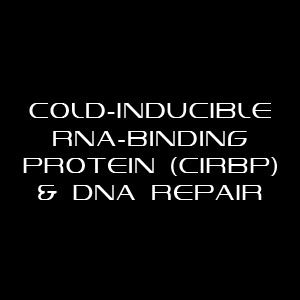FASTING MIMICKING DIET
February 2, 2022CARBONYL SCAVENGER
February 2, 2022
- PARP-1–dependent recruitment of cold-inducible RNA-binding protein promotes double-strand break repair and genome stability
- Controversial roles of cold‑inducible RNA‑binding protein in human cancer
- ThermomiR-377-3p-induced Suppression of CIRBP Expression Is Required for Effective Elimination of Cancer Cells and Cancer Stem-like Cells by Hyperthermia
- The Prognostic Value of DNA Methylation, Post-Translational Modifications and Correlated with Immune Infiltrates in Gynecologic Cancers
- Assessing kinetics and recruitment of DNA repair factors using high content screens
- Cold-inducible RNA binding protein promotes breast cancer cell malignancy by regulating Cystatin C levels
- Genetically-regulated transcriptomics & copy number variation of proctitis points to altered mitochondrial and DNA repair mechanisms in individuals of …
- Loss of CIRBP expression is correlated with the malignant progression and poor prognosis in nasopharyngeal carcinoma
- Cold-induced RNA-binding protein (CIRBP) regulates the expression of Src-associated during mitosis of 68 kDa (Sam68) and extracellular signal-regulated kinases …
- Down‐regulating cold shock protein genes impairs cancer cell survival and enhances chemosensitivity
- Transcriptomics & copy number variation of radiotoxicity points to altered mitochondrial and DNA repair mechanisms
- RNA helicase, DDX3X, is actively recruited to sites of DNA damage in live cells
- Cold-inducible RNA binding protein promotes breast cancer cell malignancy by regulating Cystatin C levels
- Cold-inducible RNA binding protein promotes breast cancer cell malignancy by regulating
- Therapeutic hypothermia protects photoreceptors through activating CIRBP pathway
- New Faces of old Friends: Emerging new Roles of RNA-Binding Proteins in the DNA Double-Strand Break Response
- NF-κB-dependent role for cold-inducible RNA binding protein in regulating interleukin 1β
- The SLX4/BTBD12 complex: A molecular toolkit for DNA repair
- Effects of mild cold shock (25 C) followed by warming up at 37 C on the cellular stress response
- Chronic hypoxia–induced CIRBP hypermethylation attenuates hypothermic cardioprotection via down-regulation of ubiquinone biosynthesis
- Involvement of cold inducible RNA-binding protein in severe hypoxia-induced growth arrest of neural stem cells in vitro
- The Role of Cold Inducible RNA-Binding Protein in Cardiac Physiology and Diseases
- Post-transcriptional regulation of DNA damage-responsive gene expression
- APOBEC3G rescues cells from the deleterious effects of DNA damage
- Role of PARP-catalyzed ADP-ribosylation in the crosstalk between DNA strand breaks and epigenetic regulation
- Cold‐inducible RNA binding protein in cancer and inflammation
- Identification of genes involved in cold-shock response in rainbow trout (Oncorhynchus mykiss)
- MicroRNAs regulate gene plasticity during cold shock in zebrafish larvae
- Recent progress in the research of cold-inducible RNA-binding protein
- Characterizing the role of DDX3X in DNA double strand break repair; Implications for lymphocyte biology
- Cold-Shock Domains—Abundance, Structure, Properties, and Nucleic-Acid Binding
- Transcriptome analysis reveals molecular mechanisms responsive to acute cold stress in the tropical stenothermal fish tiger barb (Puntius tetrazona)
- Absence of Cold-Inducible RNA-Binding Protein (CIRP) Promotes Angiogenesis and Regeneration of Ischemic Tissue by Inducing M2-Like Macrophage Polarization
- Coping with cold: an integrative, multitissue analysis of the transcriptome of a poikilothermic vertebrate
- DNA methylation dynamics during differentiation, proliferation, and tumorigenesis in the intestinal tract
- DNA microarray analysis of cortical gene expression during early recirculation after focal brain ischemia in rat
- Global methylation profiling in serous ovarian cancer is indicative for distinct aberrant DNA methylation signatures associated with tumor aggressiveness and disease …
- miRMap: profiling 14q32 microRNA expression and DNA methylation throughout the human vasculature
- Cold-Shock Domains—Abundance, Structure, Properties, and Nucleic-Acid Binding. Cancers 2021, 13, 190
- DNA copy number profiles during tumour progression in breast cancer
- Conserved DNA methylation combined with differential frontal cortex and cerebellar expression distinguishes C9orf72-associated and sporadic ALS, and implicates …
- Cold-inducible proteins CIRP and RBM3, a unique couple with activities far beyond the cold
- Cold-inducible RNA-binding protein CIRP/hnRNP A18 regulates telomerase activity in a temperature-dependent manner
- Quantitative proteomics reveals a “poised quiescence” cellular state after triggering the DNA replication origin activation checkpoint
- Does epigenetic regulation mediate response to cold adaptation in cellular systems?
- Long-term warm or cold acclimation elicits a specific transcriptional response and affects energy metabolism in zebrafish
- Patterns of alternative splicing in response to cold acclimation in fish
- Comparative expression analysis in mature gonads, liver and brain of turbot (Scophthalmus maximus) by cDNA-AFLPS
- Transcriptional Programs Underlying Cold Acclimation of Common Carp (Cyprinus carpio L.)
- Nasal Mesenchymal Stem Cell Treatment for the repair of Chemotherapy-Induced Neurotoxicities: Let the Trojan Horse In!
- Conserved patterns of alternative splicing in response to cold acclimation in fish
- Global identification of the genetic networks and cis-regulatory elements of the cold response in zebrafish
- Genetic analysis of murine tissue repair and inflammation
- Cold-inducible RNA-binding protein plays a central role in the pathogenesis of abdominal aortic aneurysm in a murine experimental model
- Cold‐induced chromatin compaction and nuclear retention of clock mRNAs resets the circadian rhythm
- The Absence of Extracellular Cold-Inducible RNA-Binding Protein (eCIRP) Promotes Pro-Angiogenic Microenvironmental Conditions and Angiogenesis in Muscle …
- Group II intron as cold sensor for self-preservation and bacterial conjugation
- The cold-inducible RNA-binding motif protein 3 (RBM3) prevents cell death through various mechanisms
- Transcriptomic characterization of cold acclimation in larval zebrafish
- Characterization of biological pathways regulating acute cold resistance of zebrafish
- Cold-inducible RNA-binding protein (CIRP) induces translation of the cell-cycle inhibitor p27Kip1






